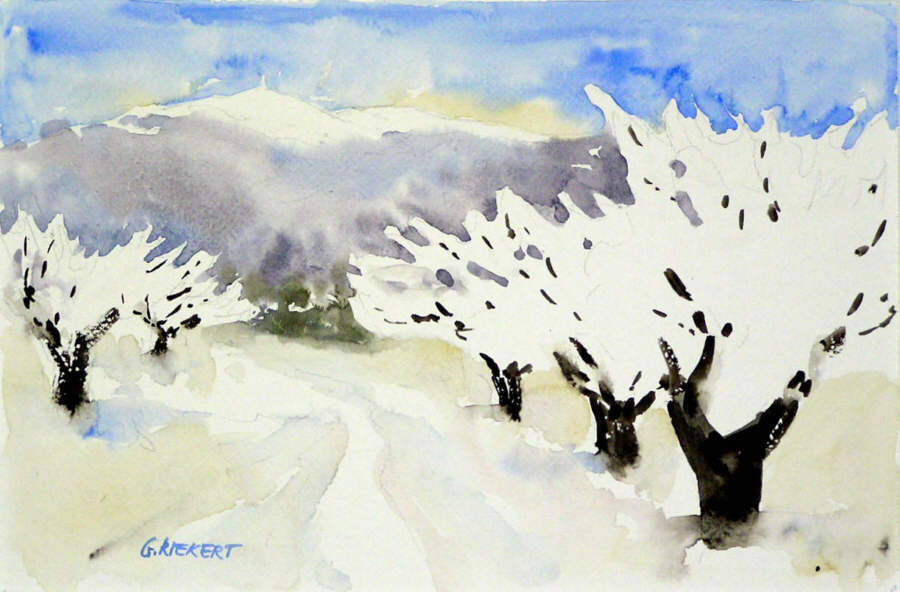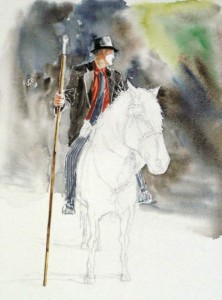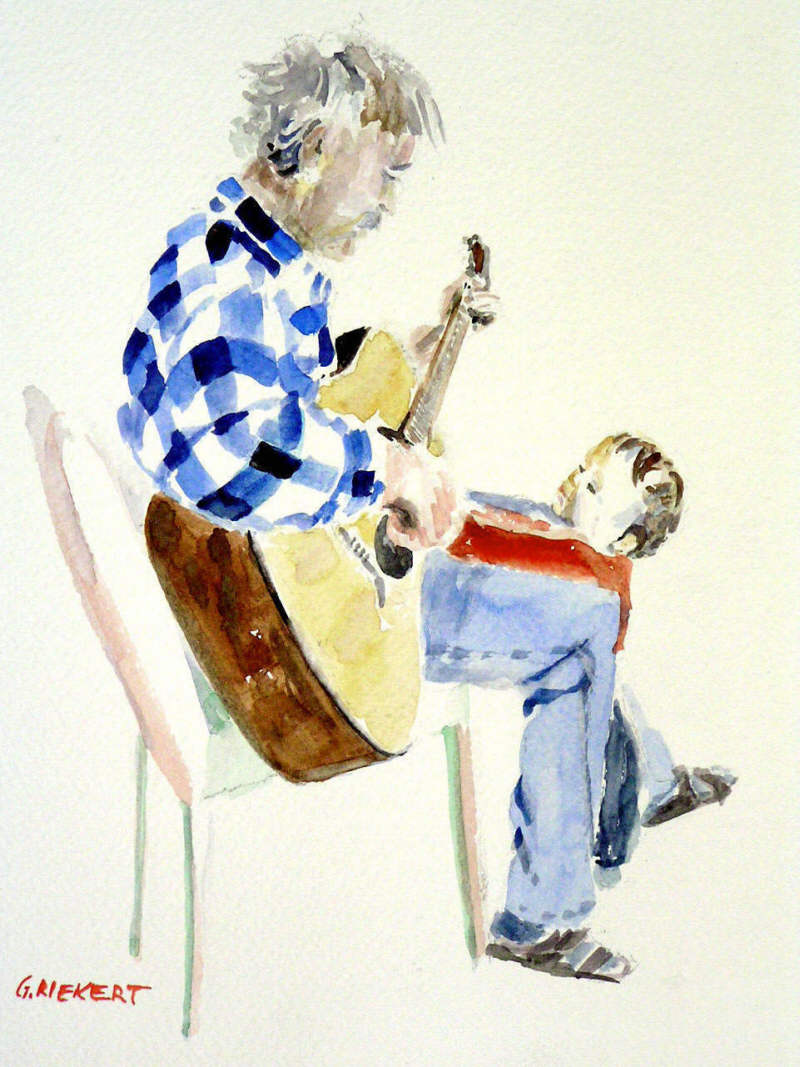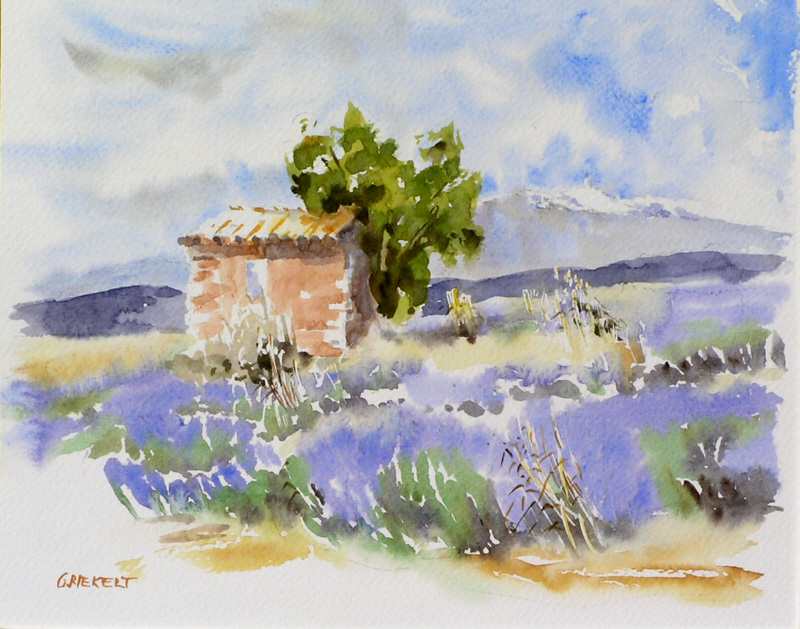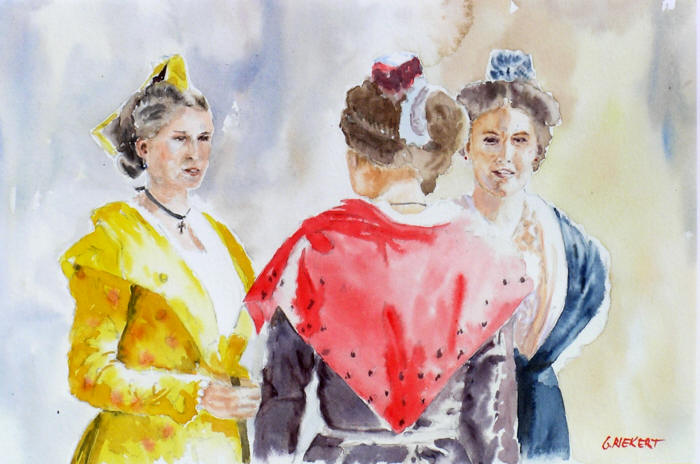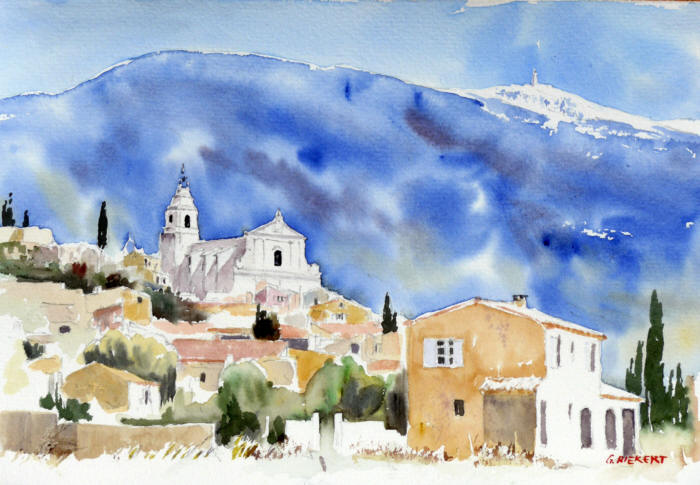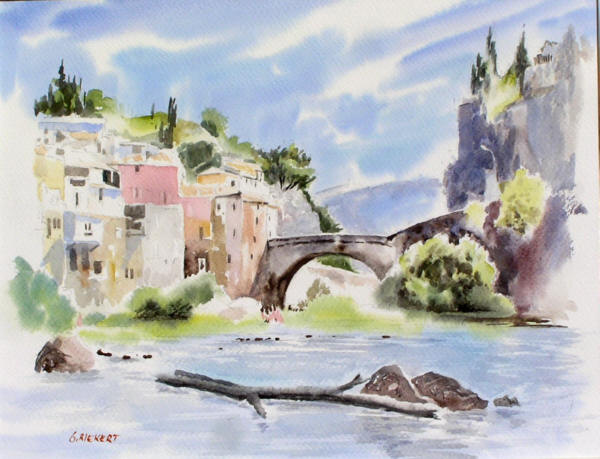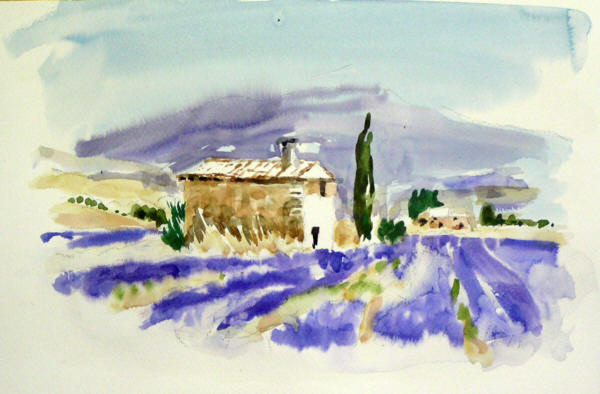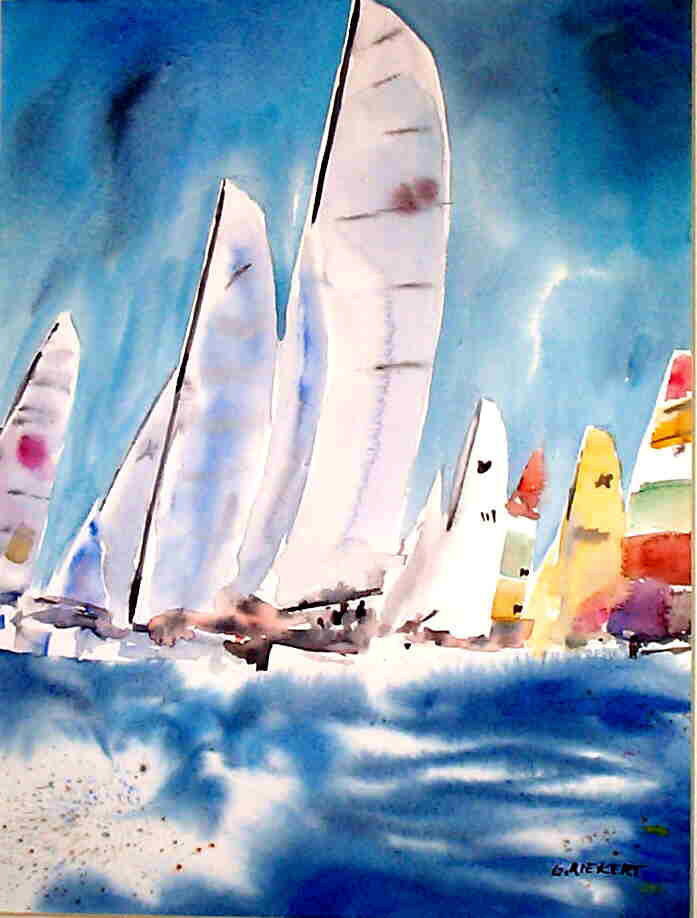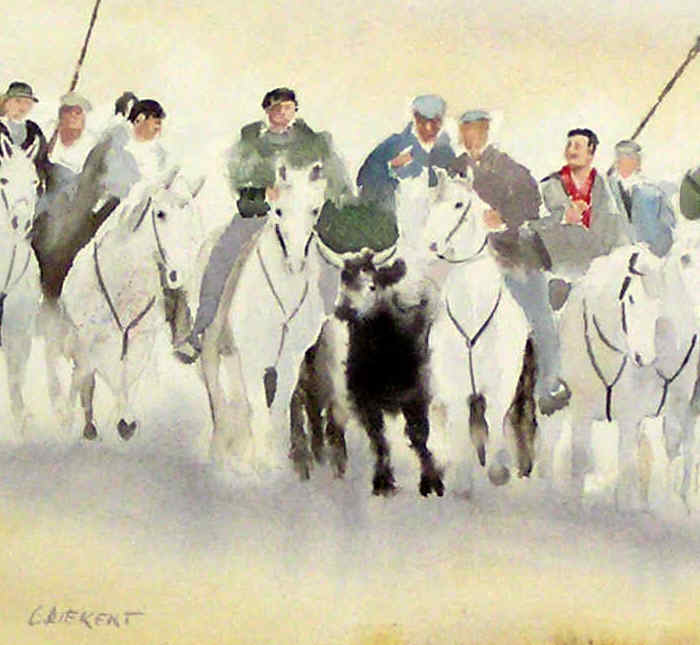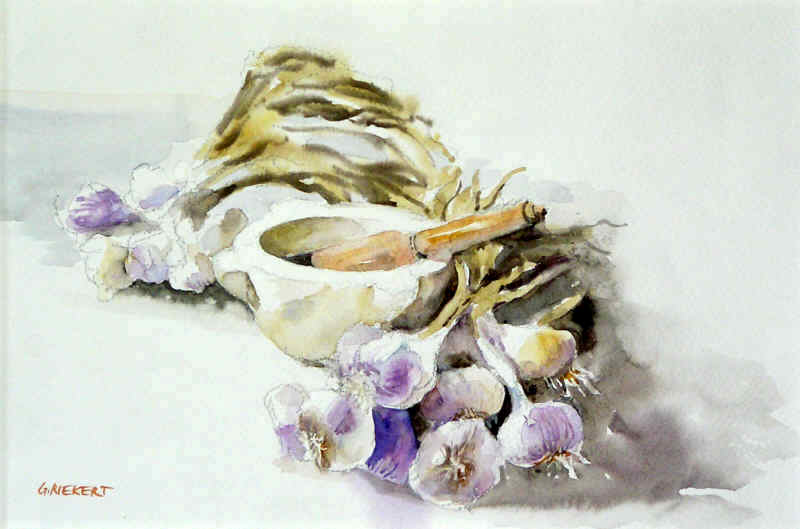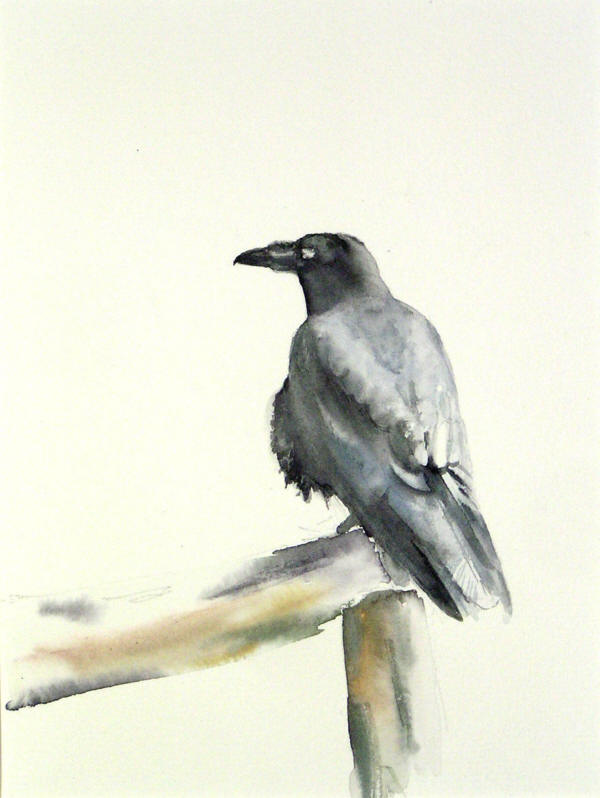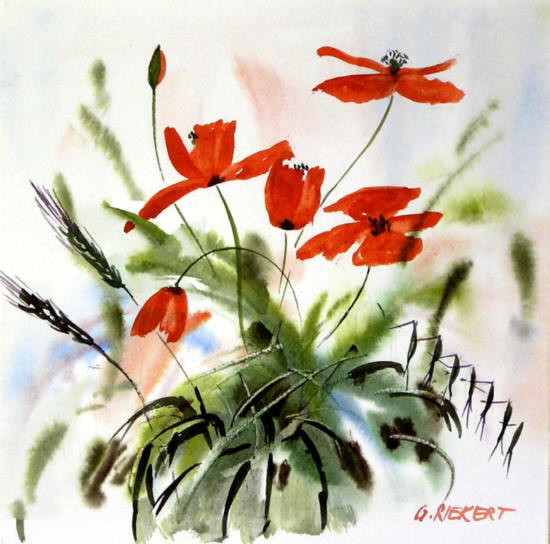Cerisaie – Cherry Orchard – Kirschgarten
14 April, 2009
Aquarelle – watercolor on Fabriano 300g/m², 19 x 29 cm
- La blancheur des cerisiers n’est obtenue qu’en peignant les troncs d’arbre très foncés. Gardez les fleurs simples, trop de détails diminueraient la force de ces formes.
- Only the very dark trunks of the cherry trees make the white of the blossoms shining. Keep the white shapes flat without much detail, which otherwise would weaken their power.
- Erst die sehr dunkel gemalten Stämme der Kirschbäume bringen die Blüten zum Leuchten. Zu viele Details würden die Kraft dieser weißen Formen schwächen.
Gardian à cheval
02 April, 2009
Aquarelle – watercolor on Fabriano 300g/m², 33 x 24 cm
- Étude d’après photo (fête de gardians à Arles). Un bon dessin est indispensable pour se familiariser avec cheval et cavalier. Quelques croquis couleurs préalable au pinceau ne sont pas du luxe. J’ai peint d’abord le fond librement qui va contraster avec personnage et animal. Il faut mouiller le papier avant de mettre la couleur (très foncé car l’humidité va la diluer d’avantage). Ensuite j’ai peint le gardian en essayant de créer quelques contours perdus (meilleur rattachement au fond). Comme je ne voulais pas mettre beaucoup de couleur en bas de l’aquarelle j’ai simplement ébauché les ombres et laissé les traits de crayon des jambes du cheval camarguais.
- Study from reference photo (fête of the Guardians at Arles). A careful drawing is necessary to get familiar with rider and horse. Some colour studies are useful. First I loosely painted the background to contrast with the detailed person and animal. Wet the paper before adding colour (very dark, as the water will dilute the paint).Then I painted the Guardian trying to create some lost edges (better integration of the person into the background). As I did not want to put much colour in the foreground of the painting, I just painted a hint of shadow and kept the pencil lines indicating the legs of the Camargue horse.
- Studie nach Foto (fête de gardians in Arles). Eine sorgfältige Zeichnung ist unerlässlich, um sich mit Ross und Reiter vertraut zu machen. Ein paar Farbstudien vorab sind auch kein Luxus. Ich habe zuerst den Hintergrund mit freien Pinselstrichen gemalt als Kontrast zu der präziser ausgeführten Person und dem Tier. Man muss das Papier anfeuchten bevor man Farbe aufbringt (sehr dunkel, da das Wasser sie ja wieder verdünnt). Dann malte ich den Gardian und versuchte einige „verlorene Konturen“ zu erzeugen (bessere Einbindung des Subjekts in den Hintergrund). Da ich im Vordergrund des Aquarells nicht viel Farbe haben wollte, malte ich die Schatten nur andeutungsweise und liess die Bleistiftzeichnung der Beine des Pferdes stehen.
Guitare quadrumane – four handed guitar – Gitarre vierhändig
16 February, 2009
Deux blondes – two Blondes – zwei Blondinen
31 January, 2009
Aquarelle – watercolor on Canson Fontenay 185g/m², 18 x 24 cm
- Pas tout à fait la suite de l’article “redondance”, même si on peut dire que 2 blondes sont déjà redondantes en quelque sorte…
- Not really a « redundancy » post but you can say that 2 Blondes are already redundant to a certain extend…
- Das ist nicht wirklich die Fortsetzung des “Redundanz“ Artikels, obwohl 2 Blondinen schon gewissermaßen redundant sind…
Redondance – Redundancy – Redundanz
05 January, 2009
La perception visuelle est un processus complexe de traitement d’information optique fourni par l’œil. Le cerveau compare continuellement cette information avec la collection de données enregistrées préalablement, une sorte de reconnaissance de formes. Pour l’identification d’un objet le cerveau reçoit souvent plus d’information que nécessaire. Ce fait est nommé « redondance » et en peinture elle joue un rôle important pour « l’événement visuel ». Dans les prochaines publications je vais en parler en détail.
Visual perception is a complex processing of optical information provided by the eye. The brain is continuously comparing this information with already recorded data, some sort of pattern recognition. To identify an object the brain often receives more data than necessary. This is called “redundancy” and in painting this plays an important role for the “visual event”. In the following posts I will explain more about it.
Visuelle Wahrnehmung ist ein komplexer Verarbeitungsprozess der Informationen, die das Auge liefert. Im Gehirn werden diese Informationen ständig mit bereits gespeicherten Daten verglichen, eine Art Strukturerkennung. Um ein Objekt zu identifizieren, erhält das Gehirn oft mehr Informationen als nötig. Dies nennt man „Redundanz“ und diese spielt in der Malerei eine wichtige Rolle für das „Wahrnehmungsereignis“. In den folgenden Beiträgen werde ich näher darauf eingehen.
Un exemple – an example – ein Beispiel:
Image 1: impossible à identifier – impossible to identify – unmöglich zu identifizieren.
